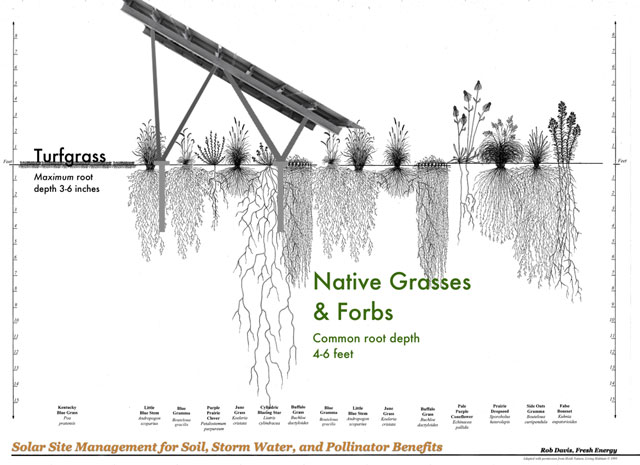Things are in bloom all over Minnesota right now, including solar energy, and more and more solar installations across the state will be supporting the creatures that pollinate our plants.
Gov. Dayton recently signed the Pollinator Friendly Solar Act into law on May 31, 2016. The Pollinator Friendly Solar Act establishes native vegetation and habitat management practices for solar developers and local governments alike to maximize habitat creation for birds, pollinators, and other small wildlife. The new law serves to verify claims that commercial solar installations are helping to create pollinator habitat. CERTs scoured all of the guidance available and put together this blog post. Read on to get the details and download key resources.
Available Guidance
Thanks to the Minnesota Board of Water & Soil Resources (BWSR) and the Minnesota Department of Natural Resources (DNR), solar developers and communities now have useful standards and technical guidance for establishing and maintaining native prairie in the footprints of commercial solar developments.
Assessment & Planning: “Solar projects provide great opportunities for establishing high quality pollinator habitat, and the Habitat Assessment Form verifies when beneficial habitat has been created,” said Dan Shaw, BWSR’s Senior Ecologist. Now, any solar developer claiming to be ‘Pollinator Friendly’ must reach a minimum score on BWSR’s Pollinator Habitat Assessment Form. In addition to the Pollinator Habitat Assessment Form, the BWSR Pollinator Plan provides additional resources for solar developers and communities to develop pollinator habitat appropriately.
Siting & Habitat: The Minnesota Department of Natural Resources recently published in-depth materials for solar developers and communities in siting commercial solar arrays. The Commercial Solar Siting Guidance and Prairie Establishment & Maintenance: Technical Guidance for Solar Projectsdocuments provide detailed siting guidance and habitat considerations for commercial developers. The Commercial Solar Siting Guidance document communicates the importance of early coordination with DNR regional ecologists. According to the guidance document, the DNR prioritizes protecting rare species, native plant communities, native prairie, and large block habitats, among other items. It advises against fencing or suggests modifying the fencing of solar sites as fences have the potential to disrupt wildlife travel corridors. The guide also encourages solar developers to plant native seed that contains grasses and flowering forbs (herbacious flowering plants other than grasses) that are beneficial to pollinators. In addition, the document notes commercial solar developers that establish prairie on farmed land can also improve water quality, increase soil water retention, and improve soil structure with the extensive root systems of short-grass prairie.
Seed Selection: The Prairie Establishment & Maintenance: Technical Guidance for Solar Projects document is practically a how-to for establishing prairie in solar developments. It lays out detailed information on establishing pollinator-friendly, native prairie plantings at solar sites with techniques such as spot-mowing or spot-spraying for newly seeded sites. According to the guide, prairie seed mixes can be adapted to low-growing species that do not shade solar panels or interfere with their operation as well as the benefits of diversity in pollinator seed mixes. The guide also explains MN DNR’s native seed collection and deployment zones for Minnesota, gives specific planting layout options, and provides seed mix examples for solar project sites. The DNR and BWSR are working to establish state-sanctioned native prairie seed mixes appropriate for solar development. Some private seed vendors already have developed native short-growth prairie seed mixes specific for solar installations. The DNR recommends project developers work with companies who specialize in native seed and prairie restoration projects. Solar developers are welcome to Visit the DNR’s website for a list of native seed suppliers that can assist them in selecting the right seed mix for the right region of the state and help them establish prairie. Regardless, the guides are excellent tools for solar project developers and local communities to use as they move forward with commercial solar development.
Documents in Review
- BWSR Pollinator Habitat Assessment Form
- BWSR Pollinator Plan
- BWSR Pollinator Toolbox
- DNR Prairie Establishment & Maintenance: Technical Guidance for Solar Projects
- DNR Commercial Solar Siting Guidance
Pollinator habitat in context
On June 27, 2016, three scientists from the University of Minnesota (Dan Cariveau, Dr. Marla Spivak, Karen Oberhauser) took over MPR News with Tom Weber to discuss how pollinators, bees and butterflies, are doing, what is causing their decline, and how can we increase their population. Listen now.


